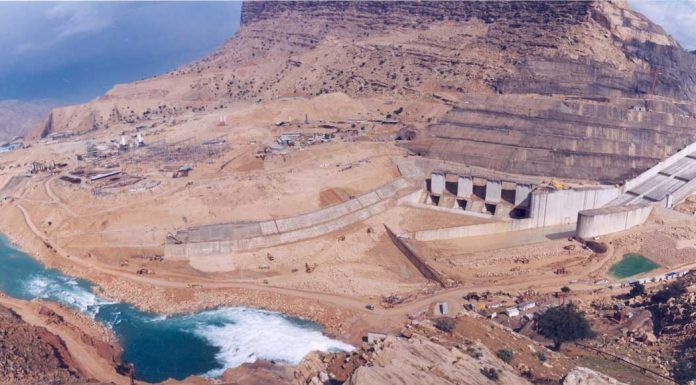Kayhan London: The salt deposit in the Gotvand Dam’s water reservoir, in the southern province of Khuzestan, rose to 10.5 million tons in 2017, causing the salinity of the Karun River to increase by 12 percent, according to Mehdi Ghomeshi, the head of the Shahid Chamran University’s School of Water Engineering in Ahvaz. The dam is in the direct path of the sedimentary basin of Aghajari Formation, also called the Upper Fars, which holds a large salt deposit.
Gotvand is an embankment dam on Iran’s only navigable Karun River which is 950 kilometers long and runs from Zardkuh mountains in the southwestern Province of Chaharmahal and Bakhtiari down through the city of Ahvaz. The increased salinity of Karun River poses an environmental challenge to the region, which has been struggling with fresh-water shortage in recent years.
“The dam is a colossal engineering mistake, and those responsible for this blunder must be held accountable,” Mr. Ghomeshi said. A report by the University of Tehran Research Institute has also described the Gotvand Dam as a “national mistake.”
The dam is a legacy of failure by three consecutive governments. The government of Ali Akbar Hashemi Rafsanjani (who was president from 1989 to 1997) finalized the preliminary planning for the dam. Its construction started during President Mohammad Khatami’s first term in office (1997–2005), and its first operational phase was commissioned in 2012 by the government of President Mahmoud Ahmadinejad (2005- 2013).
The government awarded the contract for the construction of Gotvand Dam to the Tehran-based Mahab Ghodss Consulting Engineering Company. The dam project drowned 60 villages in the counties of Masjed Soleyman and Lali. Iran’s Water and Power Resources Company (IWPC) has not compensated the residents of the villages that have been submerged. The high concentration of salt in the water has also affected the 370,000 hectares of agricultural lands.
“The amount of salt deposit in the Gotvand Dam has more than tripled in the past seven years,” Mr. Ghomeshi said. “A geological survey by the Mahab Ghodss Consulting Engineering Company showed that 18.9 percent of the soil in and around the dam is the salt deposit. That’s about 120 million tons of salt seeping into the water reservoir. The engineers tried to reduce the seepage of salt into the reservoir through the application of a plastic clay blanket in the dam. However, the measure failed during the first phase of the operation.”
“There is a massive salt deposit at the bottom of Gotvand Dam’s water reservoir which will cause serious problems if left untreated,” said Mohammadali Akhundi, a faculty member at Shahid Chamran University’s School of Water Engineering. “The province’s water problem is not limited to Gotvand Dam. The multi-phased Ghadir project, designed to supply water from the Dez River to cities of Khorramshahr and Abadan, also poses serious challenges to the province. We can’t abandon the dam at this point, but must find a scientific and technical solution to the problem.”
Mohammad Kashefipour, the head of Shahid Chamran University’s Environmental Group, said: “The Ministry of Energy has decided that removing the salt deposit from the water reservoir is the only way to tackle this problem. The IWPC is, however, managing the dam for only a short period, and therefore it is not in its financial interest to undertake a massive removal and transfer of salt deposit from the reservoir.”
Translated from Persian by Fardine Hamidi


